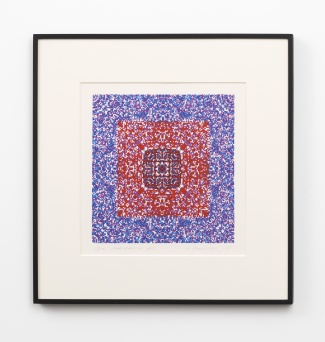





Opening Reception
Friday, September 14
5:00–7:00pm
DOCUMENT is pleased to present Poemfield, Stan VanDerBeek’s first solo exhibition at the gallery. The exhibition will present a 16mm film installation of Poemfield no. 7 (1967-68), a digital projection of the film Symmetricks (1972), and a selection of works on paper (1973-83).
VanDerBeek’s Poemfields, the artist’s most well-known series of computer-generated films, are complex, multilayered moving tapestries of abstracted images, colors, visuals, texts, and sounds. Fascinated with the computer’s ability to generate text on a screen, VanDerBeek established an “image-based poetry language.” For this series, he collaborated with computer scientist Ken Knowlton at AT&T Bell Labs beginning in 1964. Using an IBM 7094 computer and BEFLIX (short for “Bell Labs Flicks”), a computer graphic programming language that Knowlton conceived in 1963, VanDerBeek and Knowlton created eight Poemfields films between 1966-71. Each film combines the artist’s own poetry with a range of digital illustrations. Since studying under poet M.C. Richards and composer John Cage at Black Mountain College, VanDerBeek incorporated collage-like practices of chance and simultaneity, experimenting with representations of text and poetry in cinematic time.
The poetry of Poemfield no. 7 presents a thought-provoking message, one that maintains its political relevance in 2018. VanDerBeek’s poem ends: THERE IS NO WAY TO PEACE; PEACE IS THE WAY; NO MORE WAR. Movements 1 and 4 of John Cage’s composition Amores comprise the soundtrack; this same composition premiered at the historic performance of Cage’s work at the Museum of Modern Art in 1943. The synthesis of text, pattern, and sound in Poemfield no. 7 conveys a bizarre sense of foreboding, a quirky yet urgent uneasiness. Some words appear and then dissolve on the screen so quickly that one must focus intently to capture the phrase in its entirety; VanDerBeek anticipated the blink-and-you-miss-it effects of newsfeed overload and image overstimulation.
Symmetricks invites a slightly more meditative viewing. While artist-in-residence at the MIT Center for Advanced Visual Studies, VanDerBeek experimented with computer-animated drawing to explore the visual effects of rapidly tracked drawn line, symmetrical patterns, and flickering images. White forms pulse, shrink, expand, and mirror each other against the black screen, and the contrast subtly suggests colors as Symmetricks progresses. One reflects on their own interpretation of the cinematic Rorschach test upon the film’s completion.
VanDerBeek was a pioneer in the growing fields of “movie art” and “Expanded Cinema” during the 1960s and 70s. His multimedia practices forecasted many facets of later iterations of contemporary art–network aesthetics, Internet art, graphical user interfaces, and appropriations of desktop computing. Rather than employing a camera to traditionally capture images, VanDerBeek made use of the computer as an abstract notation system for making movies. He wrote pictures and visually manipulated language. VanDerBeek challenged the formal paradigms of film and moving images, adopting a collaborative, pluralistic, and multisensory approach to filmmaking that resonates with today’s prevalence of multimedia art and the feedback loop of everyday digital life.
—
Stan VanDerBeek (b. New York, 1927-1984) studied visual art at The Cooper Union for the Advancement of Science and Art, New York and then at Black Mountain College in Asheville, North Carolina, receiving honorary doctorates from both schools in 1957 and 1972, respectively. He began his artistic career as a painter but soon moved on to create animated collage films made of altered paintings and newspaper and magazine clippings. VanDerBeek’s research into developing visual languages as ways of communication led him to seek out expertise from individuals pioneering in the fields of film technology, digital media, and computers. He worked with Ken Knowlton at AT&T’s Bell Labs and served as an artist-in-residence, collaborator, and instructor at a number of organizations and research universities during his artistic career. He was a professor of art and film at University of Maryland, Baltimore County from 1975 until his death in 1984.
Among VanDerBeek’s numerous awards are grants from the Rockefeller Foundation, the Guggenheim Foundation, the Ford Foundation, and the National Endowment for the Arts; and an American Film Institute Independent Filmmaker Award. VanDerBeek’s work has been featured in countless international exhibitions over the past six decades, beginning with the pioneering exhibitions Cybernetic Serendipity, Institute of Contemporary Art (ICA), London, and Smithsonian Institute, Washington, D.C. (1968-69); The Projected Image, Institute of Contemporary Art, Boston (1968); and Software, The Jewish Museum, New York (1970). Recent exhibitions include Thinking Machines: Art and Design in the Computer Age, The Museum of Modern Art, NY (2017); Merce Cunningham: Common Time, Walker Art Center, Minneapolis, MN (2017); Delirious: Art at the Limits of Reason, 1950-1980, The Met Breuer, New York, NY (2017); Dreamlands: Immersive Cinema and Art, 1905-2016, Whitney Museum of American Art, New York, NY (2016); Leap Before You Look: Black Mountain College, 1933-1957, Institute of Contemporary Art, Boston (2015); Stan VanDerBeek: Poemfield, Andrea Rosen Gallery 2, New York (2015); Cosa Mentale: Art et Télépathie au XX Siécle, Centre Pompidou-Metz, Lorraine, France (2015); Venice Biennale (2013); and Stan VanDerBeek: The Culture Intercom, MIT List Visual Arts Center, Cambridge and Contemporary Arts Museum Houston (2012). VanDerBeek’s films have been presented in numerous moving image screening programs, including Cine Dreams: Future Cinema of the Mind, 1972, Planetario Galileo Galilei, Buenos Aires (part of Art Basel Cities Week, 2018); Experimental Animation, Anthology Film Archives, New York (2015); Stan VanDerBeek: Newsreel of Dreams, Los Angeles Filmforum at MOCA, Los Angeles (2015); Movie-Drome, New Forms Festival, Vancouver (2014); Stan VanDerBeek: Expanded Cinema, Skissernas Museum, Lund, Sweden (2014); and Expanded Cinema: Activating the Space of Reception, Tate Modern, London (2009). Upcoming exhibitions include Judson Dance Theater: The Work is Never Done at the Museum of Modern Art, New York (2018).
VanDerBeek’s work is represented in public collections worldwide, including the Museum of Modern Art, New York; Whitney Museum of American Art, New York; Centre Pompidou, Paris; the Art Institute of Chicago; Museo Nacional Centro de Arte Reina Sofia, Madrid; Los Angeles County Museum of Art; the National Library of Australia Film Collection, Canberra; Pennsylvania State University, State College; and the Arts Council of Great Britain, London.
















